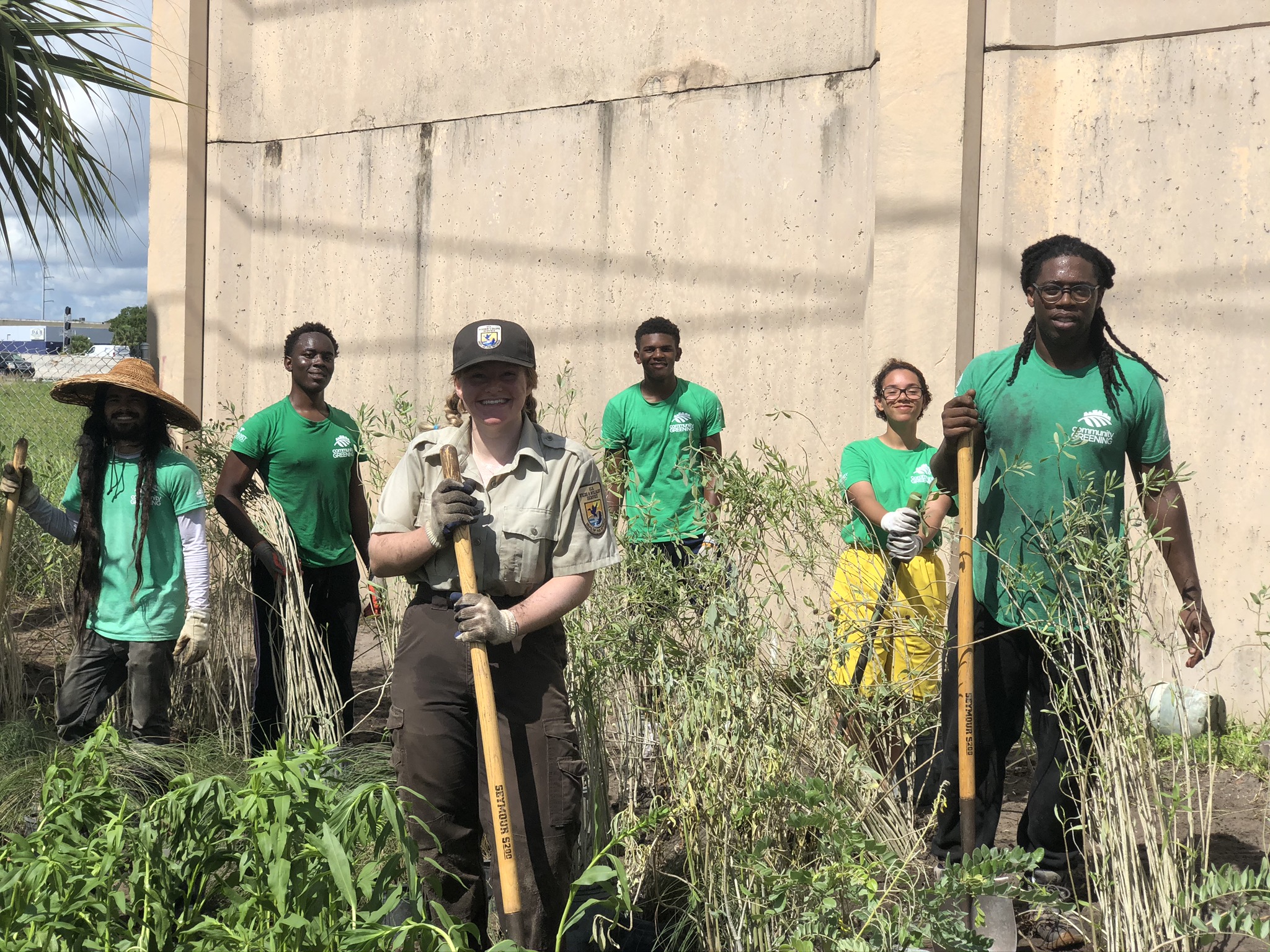PLANTING WITH THE US FISH & WILDLIFE SERVICE
Thanks to a grant from the Arthur R. Marshall Loxahatchee National Wildlife Refuge there is a native “Pocket Refuge” at the Community Grove at Catherine Strong Splash Park in Delray Beach. The 200 native wildflowers and grasses were planted by the Youth Tree Team, USFWS staff, and CG volunteers. Park Ranger David Vela led the US Fish and Wildlife Service project that adds pollinator plants to urban settings such as schools, places of worship, and public parks. Carolyn Pendleton-Parker (CG Board member and landscape architect) laid out the plants with the teens and gave them an overview about design concepts and her profession. Thank you for a strong team effort on a sweltering summer day.
About the Refuge
The Loxahatchee National Wildlife Refuge was established in 1951 under the authority of the Migratory Bird Conservation Act of 1929 with a 50-year license agreement between the State of Florida and the U.S. Fish and Wildlife Service (USFWS). In 2002, the initial license agreement was revised and renewed for an additional 50 years. In 2018, the USFWS and the South Florida Water Management District entered into a renegotiated 20-year license agreement.
In 1986, the Refuge was renamed the Arthur R. Marshall Loxahatchee National Wildlife Refuge to honor former USFWS employee and noted South Florida conservationist, Arthur Raymond Marshall.
In 2013, the refuge was designated as one of 14 priority Urban National Wildlife Refuges. The goal of the Urban Wildlife Conservation Program is to engage urban communities as partners in wildlife conservation.
In 2018, a long-planned land exchange between the USFWS and the State of Florida was finalized. USFWS divested of 1,327 acres, known as Compartment D, on the southwest side of the refuge in exchange for fee-title ownership of 2,588 acres, known as Strazzulla Marsh, on the east side of the refuge just north of the Cypress Swamp. Strazzulla Marsh is one of the last and largest rainfall-driven wetlands in South Florida and contains a portion of the largest remaining cypress swamp in Palm Beach County.
Present day, the refuge consists of 145,188 acres, or 226 square miles, of Everglades ecosystems including a mosaic of wet prairies, sawgrass ridges, sloughs, tree islands, cattail communities, and a 400-acre cypress swamp. These lands provides habitat — food, water, shelter, and space — for more than 250 species of birds, 60 species of reptiles and amphibians, 40 species of butterflies, and 20 types of mammals. Learn more about refuge wildlife and its habitats.
The refuge also provides habitat and protection for endangered and threatened wildlife such as the American alligator, snail kite, and wood stork. Migratory birds such as Neotropical songbirds, secretive marsh birds, shorebirds, raptors, and waterfowl winter at the refuge, along with a great variety of year-round resident wading birds and other wildlife. Through refuge programs and facilities, visitors can enjoy a variety of educational and wildlife-oriented recreational opportunities such as guided birdwatching and interpretive wildlife tours. View our calendar of events.
The refuge is located seven miles west of the city of Boynton Beach, in Palm Beach County, Florida. Palm Beach County is one of the largest counties in Florida. The refuge is located west of U.S. Highway 441, south of U.S. Highway 80, and 15 miles west of the Atlantic Ocean. View information about our hours and entrances fees.
US Fish and Wildlife Service
The United States Fish and Wildlife Service is an agency of the US federal government within the US Department of the Interior dedicated to the management of fish, wildlife, and natural habitats.
The mission of the U.S. Fish and Wildlife Service is working with others to conserve, protect, and enhance fish, wildlife, plants, and their habitats for the continuing benefit of the American people.
We are the principal federal agency responsible for conserving, protecting, and enhancing fish, wildlife, and plants and their habitats for the continuing benefit of the American people.
We meet our mission by working with others. The vast majority of fish and wildlife habitat is on lands not owned by the federal government. Partnerships with Native American tribes, state and local governments, nongovernment organizations and private citizens are critical to fulfilling our mission.
The Midwest Region of the Service includes Illinois, Indiana, Iowa, Michigan, Minnesota, Missouri, Ohio and Wisconsin.
The region is committed to
- Expanding partnerships offering innovative opportunities to enhance the region
- Healthy fish and wildlife trust species populations and habitats to support them
- Providing the public with quality hunting, fishing, wildlife watching, and other wildlife-dependent recreational opportunities on Service lands
